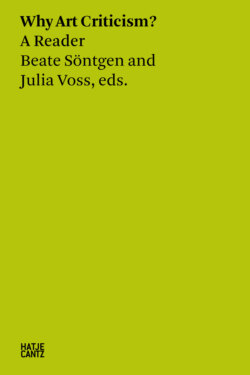Читать книгу Why Art Criticism? A Reader - Группа авторов - Страница 26
ОглавлениеGeorges Bataille
In Georges Bataille’s (1897–1962) multifaceted work, which cuts across disciplinary boundaries and resists attempts at stable classification, the idea of criticism occupies a singular place. Throughout his career, Bataille used the role of the critic to position himself in contemporary debates, radically reconfiguring the received understanding of a critical écriture in the course of these interventions. The programmatic significance of criticism for Bataille is particularly evident in his founding of the French journal Critique in 1946. Mostly dedicated to book reviews, yet strictly opposed to any disciplinary compartmentalization, the journal quickly established itself as an important voice in French intellectual life and continues to be published today.
For Bataille, the idea of criticism is not, however, limited to a critique of the written word, as evinced by the articles published here. In his early work, Bataille’s criticism traversed a variety of fields, especially in the texts he wrote for the short-lived journal Documents. Although much remains uncertain about its genesis, it is clear that Bataille had a central role in founding and editing the journal, which was published in fifteen issues between 1929 and 1930. A hub for dissident Surrealists, Documents was characterized by its use of unexpected text-image constellations and its heterogeneous contents, which spanned, according to the magazine’s cover, “Doctrines, Archeology, Fine Art, and Ethnography” (“Variety” was later exchanged for “Doctrines”).
Under the appearance of a high-gloss journal, Documents became what Michel Leiris—a close friend of Bataille’s and one of the journal’s contributors—described as a “war machine against established ideas.” In this vein, Bataille’s essays demarcate a domain of what is “wholly other” to contemporary culture: its negative underside, constituted by all that has been excluded and repressed. Two of the texts included here—the essay on Les pieds Nickelés and the review of Joan Miró—are from the fourth and seventh issues, respectively, of the 1930 volume of Documents. Eschewing a literal understanding of negation, these interventions suggest that the dismemberment of the human figure, the scattering of random marks, and the obscuring of vision in Miró’s painting is more prone to invoke and materialize this otherness than the anti-artistic strategies of Dada. Although Bataille was never formally a member of the group, his writings can be understood as an attempt to shift and radicalize the Surrealist aesthetic, which he depreciated for its persistent idealism. The third text published here—a review of works by André Breton, Paul Éluard, and Tristan Tzara from 1932—reveals how Bataille’s criticism continued to grapple with Surrealism as an intimate enemy and crucial interlocutor.
While the art-theoretical reception of Bataille’s early work by Rosalind Krauss, Yve-Alain Bois, and Georges Didi-Huberman has established the importance of his notion of the “formless,” the essay on Miró employs an equally important concept in his critical lexicon: the notion of “decomposition,” understood in the dual sense of declassification and decay, the latter referring to the rotting corpse as a marker for what culture must repress in order to constitute itself. The transformation that the idea of criticism undergoes in Bataille’s work could be seen in accordance with this twofold operation. Criticism as practiced by Bataille is not a form of judgment according to established criteria. On the contrary, it is an undoing of established criteria, a form of writing that vindicates decomposition and destruction as constitutive elements of contemporary art, and also seeks to perform such a decomposition of meaning in the text.
What Bataille’s writing shares with the Enlightenment tradition of French art criticism is the privilege granted to the sensuous experience of art. Yet, for Bataille, the experience of art should not be distanced and pleasant; it should be shocking, violent, and transgressive. In contradistinction to the Enlightenment subject of critique, which affirms its autonomy through acts of judgment, Bataille’s criticism is keyed to an experience of desublimation and alterity that unsettles the viewer’s sensibility. Aside from the historical importance of Bataille’s work, the enduring relevance of his criticism consists in its attempt to problematize and transform dominant forms, rather than to stabilize and implement them. In so doing, Bataille’s writing poses the exigent question about the criticality of art criticism: can critique operate on the side of the wholly other?
